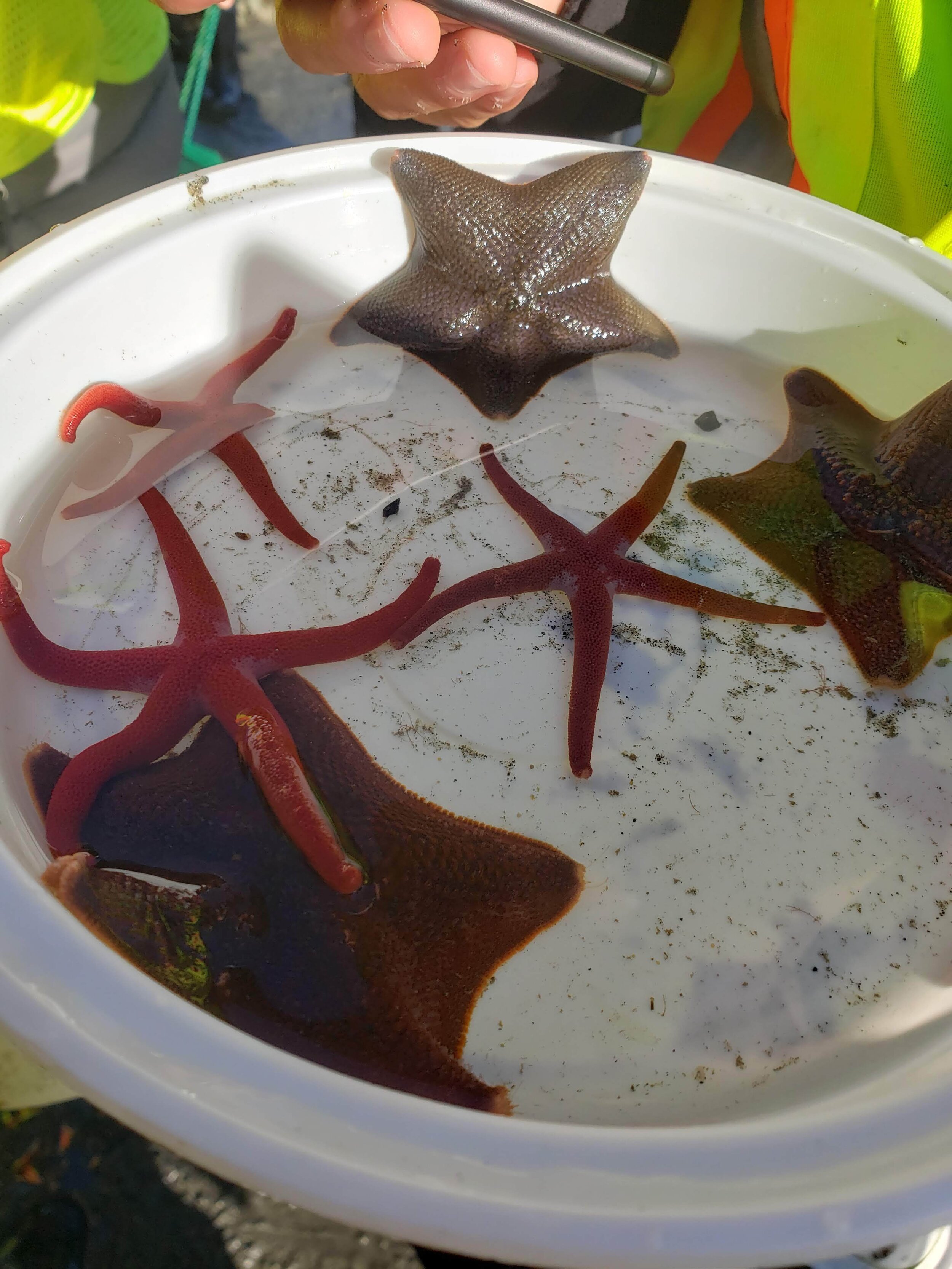Haida Gwaii has 5000km of shoreline between its 200 islands, but they are not made equal. An early morning trip was necessary to catch our rocky intertidal study site at low tide, exposing the slick hard shore sprawling with wildlife. Here, wave-exposed bedrock houses dozens of species despite its low primary productivity and retention. Constant disturbance from waves prevents local (or authochtonous) growth, but the high tide brings ample external inputs. A rapid biobltiz at the site found several species of crab, limpets, barnacles, sea anemone, sea stars, tunichates, chitons, snails, nudibranchs, sea cucumbers, jellyfish, and bottom-feeding fish. On a lucky day, you can find an octopus underneath the rocks and boulders. The intermediate disturbance of the waves creates a diverse ecosystem here, thus competition on the rocky intertidal is fierce. The community composition of each stretch of shoreline is dependent on four factors: the tide height, tide position, wave shock, and substrate.
The influx of wrack (aka seaweed and algae) greatly influences community composition and nutrient availability. At the start of our study, we collected wrack samples from a cobble shore, placed them in exposed but buried containers above the high tide point, and observed the decay over three weeks. We found macrokelps like bull kelp (Nereocystis sp.) and giant kelp (Macrocystis pyrifera) to be the most influential in providing short term nutrients to the terrestrial system. Decay was evident in thinner kelps such as Turkish Towel (Chondracanthus exasperatus), while thicker macrokelps remained mostly intact.
Our wrack samples had been most notably colonised by small bugs called taltridae amphipods, which opportunistically use their olfactory senses to identify when kelp and algae get deposited ashore by waves. Shifting wrack samples on any beach will be met with the exposure and release of dozens of these quick small critters, commonly known as beach hoppers. Our samples also housed maggots of various wrack flies and Aegialia arenaria, a small black beetle.
Some small islands that don’t have much primary nutrient production can even be entirely donor controlled by wrack that washes up on shore. This is dependent, however, on the retention capacity of the beach – largely influenced by the substrate and wind. The wrack uptake may be 30 times greater on a cobble beach as opposed to a sandy one. Deposition location of the wrack will also vary by slope and surface structures. The buoyancy of the wrack, the extent of wave exposure, and the retention capacity of the substrate results in characteristic wrack species compositions that vary by beach. This species variation was not evident to me immediately, but the excitement of finding a new species of kelp on a new beach soon became a regular occurrence.




On Hotspring Island in Gwaii Haanas National Park Reserve, we found Halosaccion for the first time. In Misty Meadows, it appeared that Zostera was dominant. In Gwaii Haanas, efforts are underway to restore kelp forests through the culling of sea urchin populations, which have exploded following the local extirpation of sea otters. These kelp forests help to buffer wave impacts, provide a source of wrack, and create a complex structural biogenic habitat for numerous species. This is turn would transform the composition of the intertidal zone.
The extremes of location’s influence on community structure was showcased by the sand dune ecosystems of Misty Meadows, part of North America’s largest stretch of continuous beach. 74% of British Columbia’s 2500ha of sand dunes are found on Haida Gwaii. In a strange way, sand dunes are similar to salmon runs: they both work against the ordinary downstream and downwind current flow. Dunes are created with a combination of sandy substrate and strong aeolian forces. These winds regularly push and redistribute sand upwind, resulting in a highly disturbed ecosystem. At the dunes, we observed flora with clear adaptations to the harsh environment. Sea Sandwort (Honckenya peploides), Sea Rocket (Cakile sp.), Beach Pea (Lathyrus japonicas), and Coastal Strawberry (Fragaria chiloensis) were among the numerous species we identified.
Sand dune species tend to specialise in water retention and nitrogen fixation to cope with the nutrient poor conditions. Sea rockets are successful invaders worldwide and have adapted to have a terrestrial and marine seed dispersal technique. The heavy disturbance borne by sand dunes make them susceptible to colonisation by invasive vegetation. Primary productivity is often erased and buried by sand. In this system, 110kg of sand deposited per year per square meter has been recorded – a volume I can barely conceptualise. Large woody debris is often found deposited at high tide points, serving to trap sand and thus enhancing foredune development. Minimal autochthonous production results in heavy subsidisation of sandy beaches by wrack inputs.
We visited the dunes on a sunny day, where the winds and waves were mild. In that moment, it was hard to understand the stress endured by the plants or the extreme rate of deposition of the sand. I realise now that I felt the same way about every MTI we encountered. At a surface level, the ecosystems appeared stagnant. Nonetheless. the notebook I left on the sandy beach got buried within the hour. Upheaving an armful of wrack caused an explosion of hundreds of amphipods. The apparently uninteresting sample of eelgrass was covered with miniscule wrackfly maggots. The peaceful estuary was actually littered with freshly caught and discarded salmon. All these instances of revelation, of visualising a writhing and alive network of interactions at play in a seemingly silent scene, were epitomised at the Delkatla salt marsh and Tarundl estuary.
Article written by Hashveenah Manoharan
“I would like to acknowledge and extend my deepest gratitude to the Haida and all other residents of Haida Gwaii, the Haida Gwaii Institute and Dr. Scott Wallace for welcoming me and enabling this experience”

